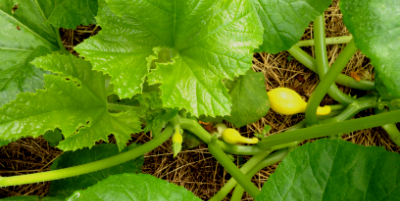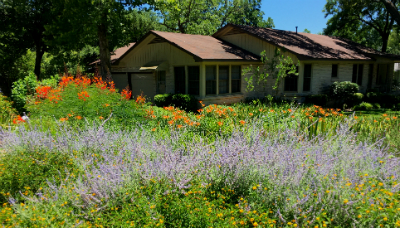
bringing nature, nurseries and gardeners together June 12, 2020
|
|
Nursery updates: the Great Outdoors has joined the other major nurseries in cautiously opening its doors to the public (masks, social distance, no kids etc.). Meanwhile the other top nurseries are up and running. It's best to check websites before visiting: Barton Springs Nursery, The Natural Gardener, Far South Nursery.
In praise of pandemic gardening: thousands of Texans are finding much-needed stress relief by digging in the dirt, and are connecting with the old-time tradition of the Victory Garden, writes Hannah J. Phillips in Texas Monthly ❦
 Battles with the Squash Vine Borer Moth
On Monday our crookneck squash plant flaunted its beauty: its large, prickly green leaves swayed comfortably in the breeze, while its mellow-yellow flowers offered the promise of fruit to come (writes Darrel Mayers). But by Wednesday, this beauty was dying a slow and messy death - yet another victim of the larvae of the notorious Melittia cucurbitae - aka the squash vine borer moth. How do gardeners beat the borer?
Tim Miller, whose famous Millberg Farm in Kyle has been certified organic for the past 31 years, was happy to share his knowledge.
"I first came across squash vine borers at the Sunshine Community Gardens back in 1984 (writes Tim). We wrapped aluminum foil around the stems at the base of the plants. If we thought the borer was already in the stem, we would use a tiny wire to kill them.
"While at the Gardens I noticed that the really big vining squashes always seemed to be unaffected. So at our farm I now grow Tatume Summer Squash. This heirloom variety is an expansive fast-grower with a fairly tough vine at its base.
"If there's lot of rain, you can encourage it to re-root 6 - 9 foot away from the main root system. This re-energizes the plant and you can enjoy a late fall crop." ❦

Dragon's Blood: the Ultimate Smoothie
by Linda Anderson
It’s between beet seasons but making this smoothie is a fun way to eat this healthy vegetable right now. You might just have some sliced cooked garden beets in your freezer or bottled from last spring. You can also use canned beets or beet powder.
Beets have many health benefits: they lower blood pressure and prevent kidney stones just to name a few. Hibiscus Tea also lowers blood pressure and is high in vitamin C.
You can get hibiscus dried flowers at local Mexican markets in bulk or you can simply buy tea bags. Just a scant teaspoon of the flowers in hot or warm water makes a cup of tea.
Make ahead of time: a cup of hibiscus tea, cooled off in the refrigerator. Freeze some red grapes, bananas and berries ahead of time as well. You can use cooked sliced beets or use beet powder.
The smoothie turns out to be a thick, dark red delight. Hence the name Dragon's Blood. Years ago I had this smoothie somewhere in a juice shop in Austin, but try as I may, I cannot find it again. So I figured my own recipe.
Recipe:
1 cup hibiscus tea
½ cup of greens (spinach, lettuce, beet greens, etc.)
Blend on high
Add: 1 medium beet (½ cup. sliced or cubed), cooked and cooled or 1 teaspoon of beet powder.
Blend.
Add: 1 cup mixed frozen fruits: berries, red grapes, bananas
Blend on 'high ice crushing.'
makes one large smoothie
Add stevia or sugar to sweeten the drink. Add a teaspoon of brewer’s yeast if you want to be extra healthy.
If it is too runny, add frozen fruit or ice. Too thick, add water or tea. I always taste before I finish blending. Enjoy! ❦
_________________________________________________
Thursday Morning Landscape
design + installation
free consultation call Dwight: 512 913 2189
_________________________________________________
Central Texas Gardener: on tour, a visit to Fort Hood’s community gardens, where veterans help families and soldiers grow together. In the studio Vincent Debrock describes how to create a tree canopy that cools us and nurtures our treasured wildlife. Sat. 4 p.m. and Sun. 9 a.m. KLRU ❦
 A pretty garden basks in the sunlight on 39th Street near Willowbrook Reach yesterday afternoon. A mass planting of whispy, purple-blue Russian sage in the foreground contrasts with the variety of oranges of the prides of Barbados.
June in the Garden
by Chris Winslow
1. Water Early morning is the optimim time… otherwise most of the irrigation water evaporates. Deep soaking is best because it gives the plant a greater reservoir to draw from.
2. Native tree care This month generally turns out to be pretty hot and dry. Remember your trees are going to be thirsty too. A small amount of rain does little to carry moisture deep into the soil.
3. Mulch This will cool the roots and slow the water loss from evaporation. Mixing your mulch 50:50 (bag-for-bag) with compost, will add nutrition and relieve stress.
4. Slow release fertilizers When feeding flowerbeds and turf, be sure to use an organic-based, slow-release fertilizer. You will avoid burning plant roots in the summer heat and will have little impact on our watershed. Foliar sprays with seaweed will also help reduce heat stress.
5. Care for your roses The first flush of your spring roses has finished. The flowering ends of the rose stems have probably formed hips (seed pods). Cut them off and there will be a new round of flowering. Also, give them some rose food. Examine them for any sign of insects, especially spidermites, and treat with horticultural oil (Sunspray or All Seasons) or Spinosad.
6. Mow high Cut your grass as high as you can stand. Longer grass blades will help shade the turf and conserve water. Leave clippings on the lawn.
7. Add summer color This is the right time to plant heat-loving summer color in those empty spaces. Planting in the morning and evening is best. For summer color, zinnias, purslane, moss rose, and vinca seem to be the hardiest. Make sure they get enough water when they are establishing themselves. Happy gardening everyone. ❦
|
 It's About Thyme Legacy Publications.
Contact newsletter editor Darrel Mayers with any ideas for articles or interesting links at internationalrain@yahoo.com (hitting 'reply' to this email won't work) |
|
|
